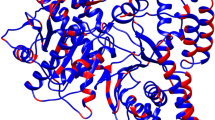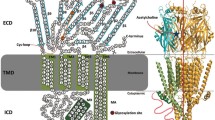Summary
-
1.
Authentic human acetylcholinesterase (AChE) was expressed inEscherichia coli under regulation of the constitutivedeo promoter or the thermoinducibleλPL promoter.
-
2.
To facilitate expression in the prokaryotic system, recombinant human AChE (rhAChE) cDNA was modified at the N terminus by oligonucleotide substitutions in order to replace some of the GC-rich regions by AT. These modifications did not alter the amino acid sequence but resulted in ample production of the protein.
-
3.
rhAChE accumulated in the cells and reached a level of 10% of total bacterial proteins. A partially purified inactive recombinant protein was recovered from inclusion bodies.
-
4.
Active rhAChE was obtained after solubilization, folding, and oxidation, although the recovery of the active enzyme was low. A 20- to 40-fold increase in enzymatically active rhAChE was achieved by replacing Cys580 by serine.
-
5.
The recombinant enzyme analogue was indistinguishable from native AChE isolated from erythrocytes in terms of substrate specificity and inhibitor selectivity.
Similar content being viewed by others
Rererences
Ashani, Y., Shapira, S., Levy, D., Wolfe, A. D., Doctor, B. P., and Raveh, L. (1991). Butyrylcholinesterase and acetylcholinesterase prophylaxis against Soman poisoning in mice.Biochem. Pharmacol. 4137–41.
Bidstrup, P. L. (1950). Poisoning by organic phosphorus insecticides.Br. Med. J. 2548–551.
Bradford, M. M. (1976). A rapid and sensitive method for quantitation of microgram quantities of protein utilizing the principle of protein-dye binding.Anal. Biochem. 72248–254.
Buchner, J., and Rudolph, R. (1991). Renaturation, purification and characterization of recombinant Fab-fragments produced in Escherichia coli.Biotechnology 9157–162.
Dacre, J. C. (1984). Toxicology of some anticholinesterases used as chemical warfare agents—A review. InCholinesterases (M. Brzin; E. A. Barnard, and D. Shet, Eds.), Walter de Gruyter, New York, pp. 415–426.
Dudai, Y., Silman, I., Shinitzky, M., and Blumberg, S. (1972). Purification by affinity chromatography of the molecular forms of acetylcholinesterase present in fresh electric-organ tissue of electric eel.Proc. Natl. Acad. Sci. USA 692400–2403.
Ellman, G. L., Courtney, D. C., Andres, V., Jr., and Featherstone, R. M. (1961). A new and rapid colorimetric determination of acetylcholinesterase activity.Biochem. Pharmacol. 788–95.
Fischer, M., Fytlovitch, S., Amit, B., Wortzel, A., and Beck, Y. (1990). A constitutive expression vector system driven by thedeo P1P2 promoters of Escherichia coli.Appl. Microbiol. Biotechnol. 33424–428.
Hartman, Y. R., Geller, T., Yavin, Z., Bartfeld, D., Kanner, D., Aviv, H., and Gorecki, M. (1986). High level expression of enzymatically active human Cu/Zn superoxide dismutase in Escherichia coli.Proc. Natl. Acad. Sci. USA 837142–7146.
Hodgson, A. J., and Chubb, I. W. (1983). Isolation of secretatory forms of soluble acetylcholinesterase by using affinity chromatography on Edrophonium Sepharose.J. Neurochem. 41654–662.
Koelle, G. B. (1972). InAnticholesterases Agents, 5th ed. (L. S. Goodman and A. Gilman, Eds.) Macmillan, New York, pp. 445–466.
Kozak, M. (1973). Comparison of initiation of protein synthesis in prokaryotes, eukaryotes and organelles.Microbiol. Rev. 471–45.
Laemmli, U. K. (1970). Cleavage of structural proteins during the assembly of the head of the bacteriophage T4.Nature 227680–685.
Looman, A. C., Bodlaender, J., deGruyter, M., Vogelaar, A., and van Knippenberg, P. H. (1986). Secondary structure as primary determinant of the efficiency of ribosomal binding sites in Escherichia coli.Nucleic Acid Res. 145481–5497.
Mitraki, A., and King, J. (1989). Protein folding intermediates and inclusion body formation.Biotechnology 7690–697.
Namba, T., Notle, C. T., Jackrel, J., and Grob, D. (1971). Poisoning due to organophosphate insecticides; Acute and chronic manifestations.Am. J. Med. 50475–492.
Raveh, L., Ashani, Y., Levy, D., DeLa Hoz, D., Wolfe, A. D., and Doctor, B. P. (1989). Acetylcholinesterase prophylaxis against organophosphate poisoning.Biochem. Pharmacol. 38529–534.
Sanger, F., Nicklen, S., and Coulson, A. R. (1977). DNA sequencing with chain terminating inhibitors.Proc. Natl. Acad. Sci. USA 745463–5467.
Silver, A. (1974).The Biology of Cholinesterases, North-Holland, Amsterdam.
Soreq, H., Ben-Aziz, R., Prody, C. A., Seidman, S., Gnatt, A., Neville, L., Lieman-Hurwitz, J., Lev-Lehman, E., Ginzberg, D., Lapidot-Lifson, Y., and Zakut, H. (1990). Molecular cloning and construction of the coding region for human acetylcholinesterase reveals a G + C rich attenuating structure.Proc. Natl. Acad. Sci. USA 879688–9692.
Sussman, J. L., Harel, M., Frolow, F., Oefner, C., Goldman, A., Toker, L., and Silman, I. (1991). Atomic structure of acetylcholinesterase from Torpedo Californica: A prototypic acetylcholine binding protein.Science 253872–879.
Velan, B., Kronman, C., Grosfeld, H., Leitner, M., Gozes, Y., Flashner, Y., Sery, T., Cohen, S., Ben-Aziz, R., Seidman, S., Shafferman, A., and Soreq, H. (1991a). Recombinant human acetylcholinesterase is secreted from transiently transfected 293 cells as soluble globular enzyme.Cell. Mol. Neurobiol. 11143–156.
Velan, B., Grosfeld, H., Kronman, C., Leitner, M., Gozes, Y., Lazar, A., Flashner, Y., Marcus, D., Cohen, S., and Shafferman, A. (1991b). The effect of elimination of intersubunit disulfide bonds in the activity, assembly and secretion of recombinant human acetylcholinesterase.J. Biol. Chem. 22623977–23984.
Author information
Authors and Affiliations
Rights and permissions
About this article
Cite this article
Fischer, M., Ittah, A., Liefer, I. et al. Expression and reconstitution of biologically active human acetylcholinesterase fromEscherichia coli . Cell Mol Neurobiol 13, 25–38 (1993). https://doi.org/10.1007/BF00712987
Received:
Accepted:
Issue Date:
DOI: https://doi.org/10.1007/BF00712987




